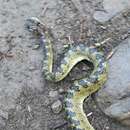mk
имиња во трошки


The genus Protobothrops was described to accommodate two species previously placed in the genus Trimeresurus, T. jerdonii and T. mucrosquamatus. In a later revision of Protobothrops, Guo et al.(2007) placed 10 species in this genus.
The dangerously venomous Protobothrops kaulbacki (Smith, 1940) was originally described as Trimeresurus kaulbacki based on specimens collected from Pangnamdim, north of the Triangle in Kachin State, Upper Burma. In subsequent decades, few studies on this species have appeared because it was known only from the type locality. In 2004, a live specimen of Kaulback’s pitviper was collected from Xizang Aautonomous Region (Tibet), China, during a herpetological survey (Rao & Zhao, 2005), making it possible to include this species in molecular phylogenetic studies of the genus.
The results of the mitochondrial DNA molecular analyses by Guo et al. (2007) provide strong evidence that Protobothrops kaulbacki is more closely related to Triceratolepidophis sieversorum than to other Protobothrops species. Based o these findings, Guo et al. (2007) suggested that Zhaoermia and Triceratolepidophis should be synonymized with Protobothrops, which would then contain ten species (cornutus, elegans, flavoviridis, jerdonii, kaulbacki, mangshanensis, mucrosquamatus, sieversorum, tokarensis, and xiangchengensis). (Guo et al. 2007 and references therein). Little is known of this habitat preferences of P. kaulbacki. The lone individual known from recent work was collected from Pangnamdin (the type locality) at an elevation of 1015 m. This region is in the transition zone between temperate Northern Triangle forests and eastern alpine shrub and meadow. The more recent specimen from China (Medog Co., Xizang A.R) was captured in open grassland within a forestat an elevation of around 1000 m. Taking into consideration the rarity of this species and its appearance in Medog Co., China (in August), it is likely that this species is confined to forested parts of these localities, and may also have a limited activity period. The species is oviparous and lays 6–32 eggs per clutch. The female has been noted to show egg guarding behaviour. (Leviton et al. 2003 and references therein; Guo et al. 2007 and references therein)
Leviton et al. (2003) provide a technical description of this species: Scales in 23-25 longitudinal rows at midbody; body elongate, head long and massive with narrow snout. Canthus rostralis sharp; single large, squarish loreal; first upper labial completely separated from from nasal by a suture; second upper labial anteriorly bordering facial pit; 8-10 scales in line between supraoculars; supraoculars usually single, flat, without a vertical projection. Color dull grayish or olive green with large, blackish rhombohedral dorsal blotches, either distinct or united , smaller spots on sides; symmetrical yellow lines on head. Subcaudals paired; ventrals 201-212; subcaudals 66-78, some of the anterior scutes may be single, others paired. Hemipenes with spines. Total length: males 1340 mm, females 1410 mm; tail length: males 225 mm, females 230 mm.
Guo et al. (2007) provide a more recent and detailed formal redescription of P. kaulback, including comparisons with similar species.
Protobothrops kaulbacki, commonly known as the Kaulback's lance-headed pitviper[3] or Kaulback's lance-headed pit viper,[1][4] is a venomous pit viper species endemic to Asia. No subspecies are currently recognized.[3][5]
The specific name, kaulbacki, is in honor of British explorer Ronald Kaulback.[3][6][7][8]
Adult males of P. kaulbacki may attain a total length of 134 cm (53 in), which includes a tail 22.5 cm (8.9 in) long. Females may grow longer: maximum total length 141 cm (56 in), tail 23 cm (9.1 in). Dorsally, it is green, with a vertebral series of dark angular spots, which may be joined to form a zigzag stripe. The top of the head is black with yellow stripes. Ventrally, except for the whitish throat area, it is gray with large squarish or crescent-shaped yellow spots.[9] Scalation includes 25 rows of dorsal scales at midbody, 201–212 ventral scales, 66–78 subcaudal scales, and 8 supralabial scales of which the third is the largest.[4]
Protobothrops kaulbacki had originally been known only from the type locality, which is "Pangnamdim, north of the Triangle, Upper Burma" (Myanmar).[2] In 2005 it was reported also from Tibet (China).[1][10] It also occurs in Arunachal Pradesh (NE India).[3]
Protobothrops kaulbacki is oviparous. The adult female lays a clutch of 6–32 eggs in a hole in the ground, and then remains with the eggs to guard them. Eggs measure 48–53 mm x 26–27 mm (about 2 in x 1 in). Each hatchling is 26–27 cm (about 10½ inches) in total length.[9]
Protobothrops kaulbacki, commonly known as the Kaulback's lance-headed pitviper or Kaulback's lance-headed pit viper, is a venomous pit viper species endemic to Asia. No subspecies are currently recognized.
Protobothrops kaulbacki Protobothrops generoko animalia da. Narrastien barruko Viperidae familian sailkatuta dago.
Protobothrops kaulbacki Protobothrops generoko animalia da. Narrastien barruko Viperidae familian sailkatuta dago.
Protobothrops kaulbacki est une espèce de serpents de la famille des Viperidae[1].
Cette espèce se rencontre[1] :
Les mâles mesurent jusqu'à 134 cm dont 22,5 cm pour la queue et les femelles jusqu'à 141 cm dont 23 cm pour la queue. Cette espèce présente une teinte générale gris terne ou vert olive. Son dos est taché de grandes marques losanges noirâtres parfois reliées entre elles et de petits points sur les flancs. Sa tête présente des lignes jaunes symétriques.
Cette espèce est nommée en l'honneur de Ronald John Henry Kaulback (1909–1995)[2].
Protobothrops kaulbacki là một loài rắn trong họ Rắn lục. Loài này được Smith mô tả khoa học đầu tiên năm 1940.[1]
Protobothrops kaulbacki là một loài rắn trong họ Rắn lục. Loài này được Smith mô tả khoa học đầu tiên năm 1940.